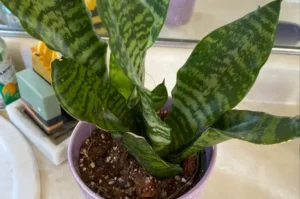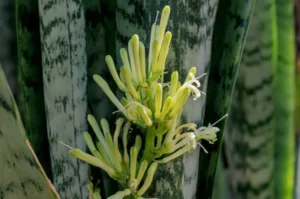Most people know snake plants as hardy, low-maintenance houseplants. But did you know that snake plants can surprise you with stunning blooms? Yes, although it’s rare, under the right conditions, a snake plant will reward you with beautiful, fragrant flowers.
The big question is: How do you care for a flowering snake plant, and maybe even make it bloom again? Let’s dive into the ultimate care guide that will help your plant not only survive but thrive and bloom.
Why Do Snake Plants Flower?
Before we talk about care, it’s important to understand why your snake plant is blooming:
- Maturity – Older, established plants are more likely to flower.
- Stress Triggers – Like being root-bound, a little stress may push your plant to bloom.
- Perfect Conditions – Consistent lighting, water, and temperature can encourage flowering.
- Bright Indirect Light – Lack of proper light is the #1 reason plants don’t flower.
PRO TIP: If you’ve had your plant for several years and you’re seeing a tall, spiky stalk rising from the center, it’s flowering time!
Best Lighting for a Flowering Snake Plant :
Light is the key factor for both snake plant growth and flowering.
What Kind of Light Helps Snake Plants Bloom?
- Place near bright, indirect light — east-facing windows are ideal.
- Avoid direct, harsh sunlight that can burn the leaves.
- Don’t keep it in dark corners if you want blooms.
Watering Tips for Flowering Snake Plants
Overwatering = No flowers + root rot.
Snake plants are succulents and prefer drier soil.
How Often to Water a Snake Plant in Bloom?
- Water only when the top 2–3 inches of soil are dry.
- Use well-draining soil and pots with drainage holes.
- Cut back on watering in winter.
What to Do When Your Snake Plant Blooms
So your plant finally bloomed, now what?
Do You Leave the Flower or Cut It?
- Leave the stalk while it’s blooming.
- Once it turns brown or yellow, snip it at the base using clean scissors.
Note: The flowers won’t last forever (usually a few weeks), but they’re lovely while they last.
Fertilizer for Flowering Snake Plants :
Snake plants don’t need much feeding, but a gentle, balanced fertilizer can boost blooms.
Which Fertilizer is Best?
- Use a 10-10-10 or 20-20-20 liquid fertilizer.
- Apply once a month during spring and summer.
- Don’t over-fertilize, it can do more harm than good.
Keyword Boost: “Best fertilizer for blooming snake plant,” “how to feed snake plant during flowering.”
Ideal Temperature & Humidity
Snake plants are tropical by nature. Here’s how to keep them happy:
- Temperature: 60–85°F (15–29°C)
- Keep away from cold drafts or air conditioners.
- Humidity: Normal room levels are fine, no need to mist.
Common Problems with Flowering Snake Plants :
| Problem | Solution |
| Flower stalk drying out too fast | This is normal after blooming. Trim the stalk. |
| No blooms for years | Improve lighting and let it stay root-bound for a bit. |
| Mushy leaves or root rot | You’re overwatering. Repot and cut back the water. |
How to Encourage Your Snake Plant to Flower Again :
Want to see blooms year after year? Follow these steps:
- Keep it slightly root-bound – Snake plants bloom better in snug pots.
- Increase light – Move to a brighter location, not full sun.
- Feed it during the growing season.
- Stress it mildly – Skip one watering to simulate drought conditions (sparingly).
- Be patient – Some snake plants take years between blooms.
Frequently Asked Questions (FAQs)
Is a flowering snake plant rare?
Yes! Not all snake plants flower. It usually happens under ideal conditions.
Is the flower poisonous?
Snake plant flowers are non-toxic to humans, but the plant itself can be mildly toxic to pets.
Can a flowering snake plant die after blooming?
No, it won’t die. It’s not like some succulents that die after flowering (e.g., agave).
Conclusion
Getting your snake plant to flower is a big achievement. Whether it’s your first bloom or a rare repeat, these flowers are a reward for your care and consistency. With the tips above, you can give your plant the perfect environment to stay healthy and bloom again.
Keep growing, and who knows? That next bloom might be just around the corner.






